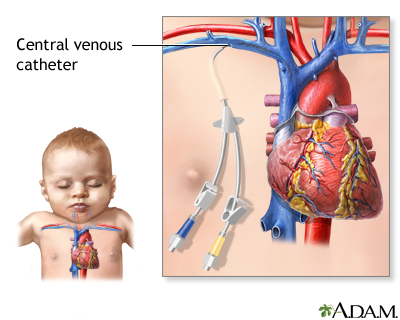Central venous line - infants
CVL - infants; Central catheter - infants - surgically placed
A central venous line is a long, soft, flexible tube that is put into a large vein in the chest.
Images

I Would Like to Learn About:
Information
WHY IS A CENTRAL VENOUS LINE USED?
A central venous line is most often put in when a baby cannot get a percutaneous inserted central catheter (PICC) or midline central catheter (MCC). A central venous line can be used to give nutrients or medicines to a baby. It is only put in when babies need IV nutrients or medicines for a long time.
HOW IS A CENTRAL VENOUS LINE PLACED?
The central venous line is put in at the hospital. The health care provider will:
- Give the baby pain medicine.
- Clean the skin on the chest with a germ-killing solution (antiseptic).
- Make a small surgical cut in the chest or groin.
- Place a hollow needle into a small vein in the arm or leg.
- Put the catheter through the hollow needle into a vein.
- Push the catheter in until the tip is close to the heart often using ultrasound guidance.
- Take an x-ray to make sure the central venous line is in the right place.
WHAT ARE THE RISKS OF A CENTRAL VENOUS LINE?
Risks include:
- There is a small risk for infection. The longer the central venous line is in, the greater the risk.
- Blood clots can form in the veins leading to the heart.
- The catheters can wear away the blood vessel wall.
- IV fluids or medicine can leak into other parts of the body. This is rare, but this can cause serious bleeding, breathing problems, and problems with the heart.
If the baby has any of these problems, the central venous line may be taken out. Talk to your baby's provider about the risks of a central venous line.
References
Centers for Disease Control and Prevention website. Guidelines for the prevention of intravascular catheter-related infections, 2011. www.cdc.gov/infectioncontrol/guidelines/BSI/index.html. Updated October 2017. Accessed January 25, 2022.
Denne SC. Parenteral nutrition for the high-risk neonate. In: Gleason CA, Juul SE, eds. Avery's Diseases of the Newborn. 10th ed. Philadelphia, PA: Elsevier; 2018:chap 69.
Edwards LR, Malone MP, et al. Pediatric vascular access and centeses. In: Fuhrman BP, Zimmerman JJ, eds. Fuhrman and Zimmerman's Pediatric Critical Care. 6th ed. Philadelphia, PA: Elsevier; 2021:chap 14.
Santillanes G, Claudius I. Pediatric vascular access and blood sampling techniques. In: Roberts J, Custalow CB, Thomsen TW, eds. Roberts and Hedges' Clinical Procedures in Emergency Medicine. 7th ed. Philadelphia, PA: Elsevier; 2019:chap 19.
BACK TO TOPReview Date: 11/9/2021
Reviewed By: Kimberly G. Lee, MD, MSc, IBCLC, Clinical Professor of Pediatrics, Division of Neonatology, Medical University of South Carolina, Charleston, SC. Review provided by VeriMed Healthcare Network. Also reviewed by David Zieve, MD, MHA, Medical Director, Brenda Conaway, Editorial Director, and the A.D.A.M. Editorial team.

Health Content Provider
06/01/2025
|
A.D.A.M., Inc. is accredited by URAC, for Health Content Provider (www.urac.org). URAC's accreditation program is an independent audit to verify that A.D.A.M. follows rigorous standards of quality and accountability. A.D.A.M. is among the first to achieve this important distinction for online health information and services. Learn more about A.D.A.M.'s editorial policy, editorial process and privacy policy. A.D.A.M. is also a founding member of Hi-Ethics. This site complied with the HONcode standard for trustworthy health information from 1995 to 2022, after which HON (Health On the Net, a not-for-profit organization that promoted transparent and reliable health information online) was discontinued. |
The information provided herein should not be used during any medical emergency or for the diagnosis or treatment of any medical condition. A licensed medical professional should be consulted for diagnosis and treatment of any and all medical conditions. Links to other sites are provided for information only -- they do not constitute endorsements of those other sites. © 1997- 2024 A.D.A.M., a business unit of Ebix, Inc. Any duplication or distribution of the information contained herein is strictly prohibited.
